Azure DevOps is a cloud-based platform by Microsoft that provides a complete set of tools for DevOps (Development & Operations). It enables teams to plan, develop, test, and deploy applications efficiently.
Why Use Azure DevOps?
- Supports CI/CD (Continuous Integration & Continuous Deployment)
- Automates software delivery
- Integrates with Azure Cloud, AWS, GCP, GitHub, Docker, and Kubernetes
- Supports any programming language (Python, Java, .NET, Node.js, etc.)
- Used by developers, IT teams, DevOps engineers, and enterprises
Azure DevOps Services/Lifecycle
The Azure DevOps lifecycle is built on five core services:
- Azure Boards – Project tracking & work management
- Azure Pipelines – CI/CD automation
- Azure Repos – Git-based version control
- Azure Test Plans – Manual & automated testing
- Azure Artifacts – Package management
1. Azure Boards: Agile Project Management
Azure Boards is an Agile project management tool that helps teams track work items, sprints, backlogs, features, and bugs throughout the development lifecycle.
Key Features:
- Customizable Workflows – Tailor workflows to match development processes
- Work Item Tracking – Manage bugs, user stories, tasks, and features
- Kanban & Scrum Support – Organize work using sprints, backlogs, and boards
- Collaboration & Reporting – Track project progress with dashboards & analytics
How to Create Work Items in Azure Boards?
- Click on + New Work Item
- Choose from options like Bug, User Story, or Task
- Assign, prioritize, and link work items to relevant features
Work Item Lifecycle Stages:
- New / To-Do – Task identified and added to backlog
- Active / In Progress – Team is actively working on the task
- In Review – Task under review for quality and approval
- Done – Work completed and deployed

2. Azure Repos: Secure & Collaborative Source Code Management
Azure Repos is a Git-based version control system that enables teams to securely store and collaborate on code.
Key Features:
- Private & Secure Repositories – Scalable Git-based repo hosting
- Branching & Version Control – Efficiently manage & merge branches
- Developer Collaboration – Use pull requests, commits, and code reviews
- CI/CD Integration – Connect with Azure Pipelines for automated builds & deployments
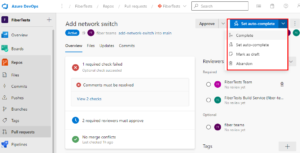
3. Azure Pipelines: Managing Environments (Dev, Testing, Production)
Azure Pipelines automates deployments across multiple environments, ensuring a smooth and controlled release process.
Why Use Environments in Azure Pipelines?
- Isolation – Separate Dev, Test, and Prod environments
- Control – Define approvals & policies before deployment
- Security – Manage secrets using Azure Key Vault integration
- Consistency – Standardized deployment process
Environments in Azure Pipelines:
- Development (Dev) – Internal testing
- Testing – QA, automated testing, and bug fixes
- Production (Prod) – Stable version deployed for end-users
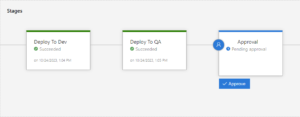
4. Azure Pipelines: Automating CI/CD for Efficient Deployment
Azure Pipelines automates building, testing, packaging, and deploying applications.
CI (Continuous Integration) Pipeline:
- Developers push code to a Git repository.
- Pipeline triggers automatically to build and test code.
- Code is compiled, unit tests run, and artifacts generated.
- Artifacts stored for later deployment.
Key Features:
- Automates code integration & prevents merge conflicts
- Runs unit tests & ensures code stability
- Generates build artifacts for deployment
- Integrates with Azure DevOps, GitHub, and GitLab
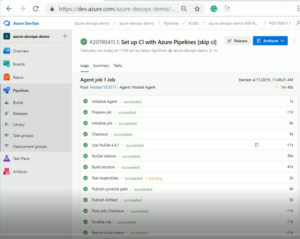
CD (Continuous Deployment) Pipeline:
- CI pipeline generates tested code packages.
- CD pipeline deploys artifacts to an environment.
- Automated tests & validation ensure successful deployment.
- Application made available to users after passing checks.
Key Features:
- Deploys automatically to different environments
- Supports approval gates for controlled releases
- Works with Azure Kubernetes Service (AKS), VMs, Web Apps
- Integrates with monitoring tools for performance tracking
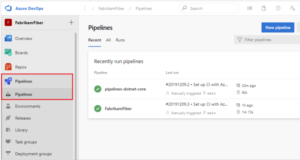
5. Azure Templates in Pipelines: Reusable & Scalable CI/CD Workflows
Azure Pipelines Templates allow breaking down a pipeline into reusable, modular files, making multi-stage deployments easier to manage.
Why Use Templates?
- Eliminates Code Duplication – Cleaner pipeline definitions
- Enforces Consistency – Standardized deployment logic
- Enhances Maintainability – Easier updates & scaling
How It Works?
- Define a Deployment Template (deploy-template.yml)
- Reference it in the Main Pipeline (azure-pipelines.yml)
- Pass environment-specific parameters
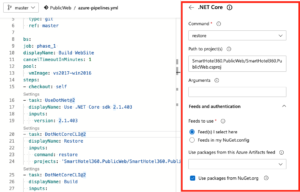
6. Azure Test Plans: Comprehensive Testing for Quality Assurance
Azure Test Plans help teams plan, execute, and track various test types to ensure software quality.
Types of Testing in Azure Test Plans:
Functional Testing – Validates application features & behavior
- Example: Checking login functionality for correct and incorrect credentials
Integration Testing – Verifies interaction between multiple components
- Example: Ensuring user registration stores data correctly & sends a confirmation email
Load Testing – Simulates real-world user traffic & stress conditions
- Example: Simulating 1,000 concurrent users logging in simultaneously
Key Features:
- Test Case Management – Organize & execute test cases
- Automated Testing – Integrate with Azure Pipelines
- Exploratory Testing – Perform session-based testing
- Rich Reporting & Tracking – Get real-time insights into test results
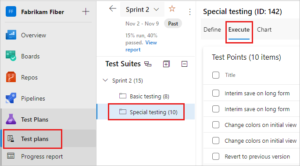
Conclusion
Azure DevOps is a powerful platform for modern software development, providing essential tools for project management, version control, CI/CD, and testing. Whether you’re a developer, DevOps engineer, or IT professional, mastering Azure DevOps services will help you streamline workflows and boost productivity.
Get Started Today: Explore Azure DevOps and start automating your development lifecycle for efficient software delivery!



